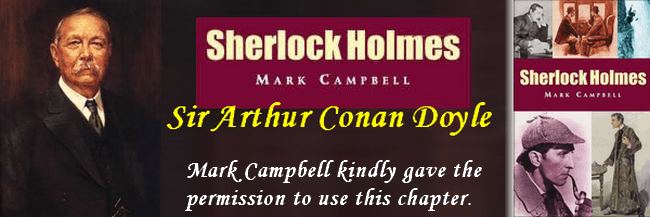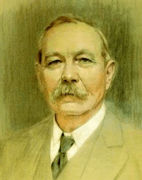
Sir Arthur Conan Doyle
Author: Mark Campbell
Arthur Conan Doyle (‘Conan’ derived from his great-uncle
Michael Conan, a distinguished journalist) was born on 22 May
1859 at 11 Picardy Place, Edinburgh, the son of Charles
Altamont Doyle and Mary (née Foley) and the second of ten
children, of whom seven survived. Doyle’s father was a civil
servant and artist, and his grandfather John Doyle was known
as the caricaturist ‘HB’. His brothers were also creative: Henry
became the manager of the National Gallery in Dublin, James
wrote The Chronicle of England and Richard, better known as
‘Dicky Doyle’, was a cover designer for Punch magazine.
In 1868 Doyle attended the Jesuit preparatory school of
Hodder in Lancashire for two years, before spending a further
seven at Stonyhurst. It was here that he rejected Catholicism in
favour of agnosticism. At 16 he did a further year in a Jesuit
school at Feldkirch in the Austrian Tyrol (where he lapped up
tales by Edgar Allan Poe) before returning to his birthplace to
study medicine at Edinburgh University from 1876 to 1881.
His first published piece, a letter entitled Gelseminum as a
Poison, appeared in the British Medical Journal of 20 September
1879. It detailed the effect of the drug on his own system. His
first (uncredited) short story, The Mystery of Sasassa Valley, was
published in the popular Chambers Edinburgh Journal in October
that year.
In 1880, Doyle sailed to the Arctic Circle as an unqualified
surgeon on the 400-ton Greenland Whaling ship Hope. A year
later he graduated from Edinburgh University as Bachelor of
Medicine and Master of Surgery, and attempted to replicate
the success of his Arctic Joumey by cruising the west coast of
Africa on the steamship Mayumba. But he suffered badly from
seasickness and decided it was not the life for him. It was
during this time that his father Charles began to receive treatment
for alcoholism and epilepsy. (He began as a fee-paying
patient and was later committed to an asylum until his death in
October 1893.)
Eccentric university colleague George Turnavine Budd
engaged Doyle to share his medical practice in Plymouth, but
later acrimoniously sacked him. Doyle (along with his brother
Innes) sailed to Southsea, a suburb of Portsmouth, and started
his own general medical practice at 1 Bush Villas, Elm Grove,
in June 1882. Business was quiet, and he turned to writing to
keep himself occupied. He joined the Portsmouth Literary and
Scientific Society in winter 1883. On 6 August 1885 Doyle
married Louise (‘Touie’) Hawkins, the sister of a patient who
had died at his premises the year before. In 1887, Beeton’s
Christmas Annual published his first Sherlock Holmes novel, A
Study in Scarlet. Two years later his first child was born, Mary
Louise, and his historical novel Micah Clarke was published.
Doyle’s second Holmes novel, The Sign of Four, appeared in
1890.
After a brief spell in Vienna in 1891, the Doyles moved to
23 Montague Place, London, where he practised as an oculist
at 2 Upper Wimpole Street, just off Harley Street. He
received very few patients and decided to write short Sherlock
Holmes stories for the new monthly magazine The Strand.
With the success of these and the publication of his novel The
White Company, he decided to give up medicine in favour of
writing.
Three months later, the Doyles rented a large house at 12
Tennison Road, South Norwood. Doyle's first son Alleyne
Kingsley was born in 1892. A year later Louise, who had
earlier contracted tuberculosis, was declared incurably
consumptive and went to the Swiss resort of Davos to convalesce.
In November 1893, Doyle joined the Society for
Psychical Research, the president of which was Arthur J
Balfour (who would later become prime minister), but it
would be another 23 years before he began proselytising
Spiritualism seriously.
Tired of Sherlock Holmes’ effect on his ‘serious’ literary
career, Doyle killed him off in The Final Problem in December
1893. The following year he went on an American lecture tour
with his brother Innes. Doyle and his wife then spent most of
1895 in Europe before moving on to a tour of Egypt. When
fighting broke out between the British and the Dervishes he
volunteered as a war correspondent for The Westminster Gazette,
giving a good account of the preparations for the campaign.
In October 1897, he and Louise moved into ‘Undershaw’,
a house he had built in Hindhead, Surrey. Because of its height
Hindhead (known as the ‘English Riviera’) was considered to
have clean, healthy air, and Doyle hoped it would aid in
Louise’s recovery. But that year he met and fell in love with
Jean Leckie.
The following year, he wrote two relatively unknown short
stories for The Strand in which Holmes makes off-stage appearances.
In The Man With the Watches (July 1898), ‘a well-known
criminal investigator’ sends an ingenious solution to the Daily
Gazette, while in The Lost Special (August 1989, later serialised
by Universal in 1932) it is implied that Moriarty is the villain
and Sherlock Holmes the ‘amateur reasoner of some
celebrity’.
In 1899 Doyle became involved in the Boer War. He sailed
to South Africa in February 1900 as part of John Langman’s
50-bed medical unit and worked in appalling conditions in a
hospital in Bloemfontein that dealt with enteric fever. He
began writing The History of the Great Boer War there, and also
published a pro-British pamphlet entitled The War in South
Africa: Its Causes and Conduct. In Doyle’s opinion, it was this
pamphlet that led to his knighthood on 9 August 1902.
Having already succumbed to public pressure and written
The Hound of the Baskervilles in 1901 (a story set before Holmes’
disappearance at the Reichenbach Falls), he finally resurrected
Sherlock Holmes properly in September 1903 in a short story
called The Empty House.
Louise died on 4 July 1906, aged 49. The same year Doyle
involved himself in the case of George Edalji, a Parsee barrister
whom he claimed had been wrongly accused of maiming
animals. The year after, Doyle married Jean Leckie and they
moved to ‘Windlesham’ , a large house in Crowborough, East
Sussex. Three children were born to this marriage: Denis
Percy Stewart (1909), Adrian Malcolm (1910) and Jean Lena
Annette (1912, known as Billy).
Doyle wrote more Sherlock Holmes short stories and
continued campaigning against injustices. He wrote a leaflet
attacking the Belgian misrule in the Congo, exposing the
suffering of the natives, and investigated the case of the
convicted murderer Oscar Slater. In 1909 he became president
(for ten years) of the Divorce Law Reform Union. Three years
later he wrote The Lost World, the first of three novels to feature
Professor Challenger.
Aged 55 when the First World War broke out, Doyle
joined the Crowborough Company of the Sixth Royal Sussex
Volunteer Regiment, but this was disbanded after a few weeks.
On 2 September 1914, the Liberal politician Charles
Masterman, head of the War Propaganda Bureau, asked Doyle
to attend a secret meeting of Britain’s leading writers to
discuss ways of best promoting Britain’s interests during the
War. After this, Doyle went away and wrote the recruiting
pamphlet To Arms! He then visited the Western Front, and the
pamphlet A Visit to the Three Fronts resulted in 1916. During the
war Doyle also started his six-volume The British Campaign in
France and Flanders, completed in 1920.
In 1916, Doyle first announced his belief in Spiritualism -
he claimed that the year before he had received a communication
from his brother-in-law Malcolm who had died at
Frameries, Belgium, in 1914. He became a passionate convert
and spent the rest of his life writing and lecturing on the
subject all around the world. His eldest son Alleyne was
wounded at the Somme and died of pneumonia in October
1918.
Doyle believed in the Cottingley Fairies (later admitted to
be a hoax), and was friends with sceptic Harry Houdini: they
exchanged a series of letters on psychic matters, later
published. He opened a psychic bookshop with a library and
museum, and set up a psychic press which published several
books.
He originally intended the short story His Last Bow (1917) to
be the final word on the Great Detective, but nevertheless
went on to write a further twelve Holmes stories over the next
seven years.
By 1925 he was dividing his time between Bignell House
near Minstead in the New Forest and his Crowborough abode.
Following a lecture tour of Scandinavia and Holland in 1929 he
developed angina pectoris and suffered a heart attack.
Bedridden for several months, he died on 7 July 1930 aged 71.
His last book, The Edge of the Unknown, had appeared a week
earlier. He was buried at Crowborough but his remains were
later moved - along with his wife Jean who died on 27 June
1940 - to Minstead Church. His tombstone inscription reads:

"Steel True
Blade Straight
Arthur Conan Doyle
Knight
Patriot, Physician & Man of Letters"
Mark Campbell kindly gave permission to use this chapter. We are very grateful.
You can buy his fantastic Sherlock Holmes book here: pocketessentials.com

Keywords: Sir Arthur Conan Doyle, life, biography, Mark Campbell, author, writer
Undershaw, literary, book, Sherlock Holmes, famous, literature, books, library

Recommended site:
Sir Arthur Conan Doyle and Hungary
Arthur Conan Doyle's life in pictures
Video: The Life of Sir Arthur Conan Doyle

|












